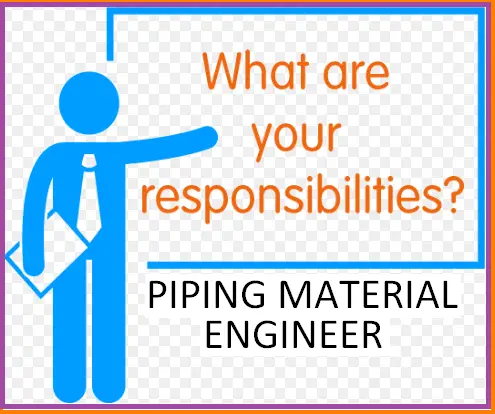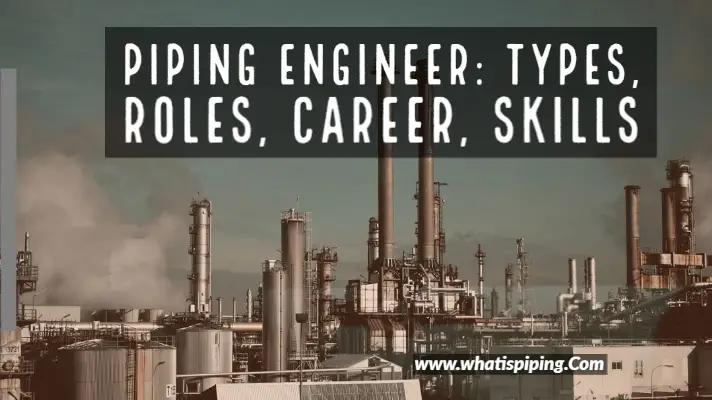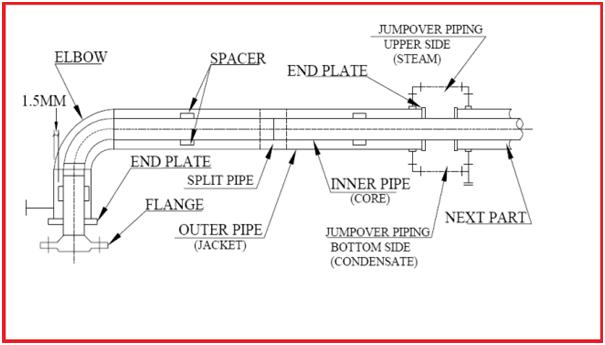In the complex world of engineering and construction, the role of piping material engineers is often overlooked yet critically important. These professionals ensure that piping systems, which are fundamental to many industrial processes, function safely, efficiently, and economically.
You must be aware that there are three sub-disciplines inside the piping discipline, namely:
- Piping Layout
- Piping Stress
- Piping Materials
Piping Materials Engineers are in the core group of the piping department. Broadly, the piping material engineer is responsible for the quality of material, creating a project pipe class, and various piping specifications required in a project to fabricate and test the piping system. Piping Materials Engineers are also sometimes called Piping Specification Engineers.
Who are Piping Materials Engineers
By Definition Piping Materials Engineers are piping engineering individuals who are responsible for creating the project piping classes and the numerous piping specifications necessary to fabricate, test, insulate, and paint the piping systems.
Whatever the title, the piping material engineer (PME) is a very important person within the Piping Design Group and should be dedicated to a project from the bid stage until the design phase has been completed. He or she should also be available during construction and through to mechanical completion.
Normally, the lead piping material engineer, the individual responsible for all piping engineering functions, usually reports directly to the project lead piping engineer. Depending on the size of the project, the lead piping material engineer may be assisted by a number of suitably qualified piping material engineers, especially during the peak period of the project. This peak period is early in the job, while the piping classes are being developed and the first bulk inquiry requisitions are sent out to vendors.
Roles and Responsibilities of Piping Material Engineers
Layout and Stress Engineer’s activities are quite evident to most people in the industry, however, the activity performed by a Piping Material Engineer is always less known and underrated. Many of us think that the piping material engineer performs only MTO (material takeoff). However, a Piping Material Engineer performs a lot of activities in a project, and his role is very important in a project.
Piping Material Engineer’s activities include but are not limited to the following:

- To Perform the Pipe Wall Thickness Calculation
- To Prepare PMS (Piping Material Specification) for Process and Utility Services.
- To Prepare VMS (Valve Material Specification)
- To Purchase All the Piping Items, which includes below:
- To Prepare MR (Material Requisition) for getting Quotations
- To Review the Vendor offers, do technical discussions with the vendors, and prepare TBE (Technical Bid Evaluation)
- To Prepare MR for Purchase
- To Review Vendor Documents
- Prepare the list of Piping Speciality Items like Steam Traps, Strainers, Hoses, etc.
- To Prepare the Data Sheets for the Piping Speciality Items
- To Perform the Line Blank Thickness Calculation
- To Perform the Reinforcement PAD Requirement calculation
- To Perform MTO (Material Take Off)
- To Control the Piping items quantity, monitor the surplus and shortage of Piping Items
- To Develop Fabrication/Welding Specifications, Shop and Field Testing Specifications, Piping Insulation, and Painting specifications.
- To Develop Technical Supply Conditions / Requirements for Various Piping Materials and to Make a technical recommendation.
- After placement of a purchase order, review and approve documentation from vendors related to piping components.
- When required, visit the vendor’s premises to attend kickoff meetings, the testing of piping components, or clarification meetings.
- Help 3D Administrator in the PMS creation in 3D Software like PDS, PDMS, etc.
- Make sure that everyone in the piping group is aware of the materials of construction that can be used for piping systems.
- To Liaise with the following departments: Piping Design and Stress, Process, Instrumentation, Vessels, Mechanical, Structural, Procurement, and Material Control.
- To Maintain project technical files and update Company standards
- To Perform the inter-disciplines checking for the part of documents in accordance with the scope of the piping material section.
So to summarize a Piping Material Engineer must be a Good Communicator, must have experience in Piping Design and Piping Material Properties, must be aware of corrosion characteristics of Piping Materials, must be aware of welding Processes necessary for the fabrication of piping systems, and must have a basic understanding of all other disciplines which have an interface with piping. Finally, He must be aware of economics which includes the material selection to reduce costly high-pressure and alloy piping runs and reduce the use of odd, high-cost fittings.
Activities of a Piping Material Engineer
Here are the main activities of a piping material engineer, presented in the order they typically occur as a project moves from initial planning to detailed design.
1. Development of Project Piping Classes
In process plants, there are two main types of piping systems: process piping and utility piping.
- Process Piping: This is the main pathway for materials in a plant. It carries feedstock, transports products through various equipment, and delivers the finished product for further processing. Process piping can be split into:
- Primary Process: The main flow of materials.
- Secondary Process: Systems for recycling materials.
- Utility Piping: This supports the primary process and is divided into three groups:
- Support: Includes instrument air, cooling water, and steam.
- Maintenance: Covers plant air and nitrogen.
- Protection: Comprises foam and firewater. Other utility services include drinking water.
Piping Classes
Each piping system is assigned a piping class that outlines all necessary components for construction. A piping class includes:
- Design conditions (temperature and pressure)
- Corrosion protection
- List of components
- Branch tables
- Special assemblies
- Support notes
Both process and utility piping systems operate under various temperatures and pressures. Important factors to analyze include:
- Fluid characteristics (corrosivity, toxicity, viscosity)
- Temperature range
- Pressure range
- Pipe size
- Joining methods
- Corrosion allowance
After examining these factors, piping systems can be grouped into classes that share similar characteristics, such as size, pressure, temperature, and joining methods. This standardization simplifies procurement, inspection, and construction.
However, there’s a balance to strike. Having too many classes can complicate paperwork and lead to errors, while too few classes may require using expensive materials for less critical services, which is known as being “overspecified.” It’s the job of the piping material engineer to optimize this classification for the project’s benefit.
For example, a typical oil and gas separation plant might have around 10 process piping classes and a similar number for utility piping. More complex petrochemical facilities may need over 50 classes to accommodate various processes and their specific temperature and pressure requirements.
2. Writing Specifications for Fabrication, Testing, Insulation, and Painting
Specifying the right materials for pipes is useless if they are built and installed by unqualified workers using poor methods, and if testing, insulation, and painting are not done properly.
The piping material engineer is tasked with creating detailed specifications for these activities to ensure they meet industry standards and the client’s needs. While each project is unique, many share similarities, and most Engineering, Procurement, and Construction (EPC) companies have general specifications that address these areas.
3. Creating Data Sheets for Process and Utility Valves
Every valve used in a process plant must have a dedicated valve data sheet (VDS). This document acts like a passport for the valve, detailing its size range, pressure rating, design temperature, materials, testing and inspection procedures, and all relevant design codes. The VDS is crucial for efficient procurement and future maintenance of the valve.
4. Creating a List of Piping Specials and Data Sheets
A piping system mainly consists of common components like pipes, fittings, and valves. However, there are also less common items, known as piping specials, such as strainers, hoses, steam traps, and interlocks. Each special item must have a unique SP number for identification.
The piping material engineer is responsible for creating and maintaining a list of SP numbers, ensuring that each special item is clearly identified by its type, material, size, and rating. Each piping special also requires its own data sheet for efficient procurement and maintenance.
5. Assembling Piping Material Requisitions with Supporting Documents
Once the piping specifications are finalized and initial quantities are determined by the Material Take-off Group, the piping material engineer assembles the requisition packages. The Procurement Department then divides the piping requirements into several requisitions, which will be sent to manufacturers that specialize in specific piping components, including:
- Pipe: Seamless and welded (carbon and stainless steel), exotic materials (Inconel, Monel, titanium)
- Pipe fittings: Seamless and welded (carbon and stainless steel)
- Valves: Gate, globe, and check (small bore, 1.5 inches and below; 2 inches and above)
- Ball valves: All sizes (carbon and stainless steel)
- Special valves: Non-slam check valves, butterfly valves
- Stud bolting: All materials
- Gaskets: Flat, spiral wound, ring type
- Special piping items (SPs): Strainers, hoses, hose couplings, sight glasses, interlocks, etc.
To obtain competitive bids, inquiries are sent to multiple manufacturers for each group of components, inviting them to provide their best prices. This includes not only supplying the items but also testing, certification, marking, packing, and shipping to the site if needed.
6. Reviewing Vendor Offers and Creating a Technical Bid Evaluation
Many clients maintain an “approved bidders list,” which includes vendors deemed suitable to supply materials based on their past performance and reliable recommendations. Prospective vendors are given a deadline to submit their bids, which must cover the specified requirements.
To foster competition, it’s best to shortlist three to six qualified vendors, ensuring they all feel they are competing with others. Even if some vendors drop out, all should believe they are in a competitive environment.
The piping material engineer evaluates all feasible bids, ensuring each vendor meets the technical specifications and is deemed “fit for purpose.” If a vendor cannot meet the requisition requirements, they are marked as technically unacceptable and excluded from further consideration.
During this evaluation, the piping material engineer creates a bid tabulation spreadsheet that lists the technical requirements for each item and assesses each vendor’s compliance. This includes evaluating materials, design codes, testing, certification, painting, as well as non-technical areas like marking and packing. The required delivery date is provided by the Material Control Group to assist in final negotiations.
The Procurement Department handles all commercial aspects, while the Project Services Group determines the delivery schedule. It’s crucial to choose a vendor who is technically acceptable and offers the best overall value, rather than just the lowest price, as the cheapest option might end up being more costly in the long run.
7. Reviewing and Approving Vendor Documentation After Purchase Order Placement
After placing an order, it’s vital to review the vendor’s documentation. Vendors must provide support documents such as inspection and testing plans, general arrangement drawings, material certifications, test certificates, and production schedules.
The piping material engineer must review and approve this documentation before the final payment can be made to the vendor.
8. Vendor Visits
The piping material engineer may need to visit the vendor’s facility to observe testing or attend clarification meetings. Some piping items are more complex due to their materials, design, or pressure ratings, requiring closer attention to ensure that the correct materials are supplied without causing production delays.
To facilitate this, the following activities should be considered:
- Bid clarification meeting: Ensures the vendor fully understands the requisition.
- Pre-inspection meeting: Discusses production, inspection, and quality control after the order is placed.
- On-site supervision: Involves having the requisition engineer at the vendor’s facility during critical manufacturing phases.
- Dedicated inspector: Places an inspector at the vendor’s site to oversee inspection and testing, ensuring specifications are followed.
The first two activities are low-cost and generally standard, while the last two may be more expensive and should be evaluated based on the complexity of the order and lead times.
Each requisition is unique; simple orders with new vendors might need more oversight than complex ones with established vendors. The decision to conduct vendor visits should also consider the inspection budget, as inadequate funding could limit on-site supervision.
Remember, receiving incorrect materials can result in high replacement costs and project delays, making it essential to ensure proper oversight, especially for custom items or those with long lead times (three months or more).
9. Bids for New Projects
In addition to project-related activities, the piping material engineer may also participate in bids for new projects invited by clients. This stage involves preliminary engineering, where accuracy is crucial, based on the client’s brief. Typical tasks include developing preliminary piping classes, basic valve data sheets, and specifications for construction, inspection, and painting.
A piping material engineer may work as part of a dedicated project task force or within a corporate group managing multiple projects at different stages. The former is often preferred, as it allows for a deeper familiarity with the evolving project.
The role of a piping material engineer is both diverse and rewarding, offering continuous learning opportunities. Even if a project has the same client, process, and geographical location, variations in personnel, budgets, and market conditions lead to unique challenges. Each project brings its own set of intricacies.
It’s essential to document and maintain your knowledge—both technical and logistical—through organized files, whether digital or in hard copy.
Regardless of whether you stay with one company for 30 years or work for multiple companies for shorter stints, the role of a piping material engineer is highly respected within the field and across projects. While it is on par with piping layout or stress engineering, its significance should not be underestimated. Proper material selection is critical; if the wrong materials are used, no matter how well the pipe is laid out, all routing efforts become irrelevant.
Piping Materials Engineer Jobs
Piping Materials Engineers are highly sought-after professionals in various industries where the design, construction, and maintenance of piping systems are critical. These engineers play a vital role in ensuring the integrity, safety, and reliability of piping networks. Here are some of the key industries where Piping Materials Engineers are recruited:
Oil and Gas Industry: Piping Materials Engineers are in high demand in the oil and gas sector. They work on projects involving pipelines, refineries, offshore platforms, and petrochemical plants.
Chemical and Petrochemical Industry: Piping Materials Engineers play a critical role in selecting materials that can withstand the corrosive and hazardous chemicals used in chemical processing plants and petrochemical facilities. They ensure compliance with industry standards to maintain safety and productivity.
Power Generation: Power plants, whether nuclear, fossil fuel-based, or renewable energy facilities, require extensive piping systems for the transport of steam, water, and other fluids. Piping Materials Engineers are responsible for selecting materials that can handle high temperatures and pressures.
Pharmaceutical and Biotechnology: Industries like pharmaceuticals and biotechnology rely on sanitary and high-purity piping systems for the production of drugs and biologics. Piping Materials Engineers work to maintain product integrity and regulatory compliance.
Mining and Minerals Processing: The mining industry utilizes extensive piping networks for transporting ores, slurries, and chemicals. Piping Materials Engineers select materials that can withstand abrasive environments and prevent corrosion.
Water and Wastewater Treatment: In municipal and industrial water treatment plants, Piping Materials Engineers are responsible for designing corrosion-resistant and durable piping systems to handle water purification, distribution, and sewage treatment.
Food and Beverage Industry: Food processing and beverage production facilities require sanitary and hygienic piping systems. Piping Materials Engineers ensure that materials meet FDA (Food and Drug Administration) and other regulatory requirements.
Nuclear Industry: Piping Materials Engineers in the nuclear industry focus on materials that can withstand radiation and extreme conditions. They play a crucial role in the safe operation of nuclear power plants.
Maritime and Shipbuilding: In shipbuilding and maritime industries, Piping Materials Engineers are involved in the design and maintenance of complex piping systems for ships, offshore platforms, and maritime infrastructure.
Building and Construction: Piping Materials Engineers also find opportunities in the building and construction sector, where they work on plumbing systems, heating, ventilation, air conditioning (HVAC) systems, and other building infrastructure projects.
Renewable Energy: With the growing focus on renewable energy sources like solar and geothermal, Piping Materials Engineers are involved in designing and maintaining piping systems for these technologies.
Automotive Industry: In automotive manufacturing, Piping Materials Engineers work on the design of fluid-carrying systems, such as fuel lines, brake lines, and cooling systems.
Research and Development: Some Piping Materials Engineers are employed in research and development roles in materials science, working on innovations in materials for various industries.
Salary of a Piping Materials Engineer
The salary of a Piping Materials Engineer can vary significantly depending on several factors, including experience, location, industry, education, and the specific employer. In India, the salaries are at the lower end whereas in the USA and Europe, the salaries are higher.
Below, I’ll provide a general salary range for Piping Materials Engineers in the USA:
- Entry-Level: Piping Materials Engineers who are just starting their careers can typically expect a salary in the range of $48,000 to $80,000 per year. This can vary based on location and industry demand.
- Mid-Career: With several years of experience, Piping Materials Engineers can earn salaries ranging from $80,000 to $120,000 per year.
- Experienced/Senior: Those with extensive experience and expertise in Piping Materials Engineering can earn salaries exceeding $120,000, often reaching $150,000 or more per year.
Few more useful Resources for You…
Resources related to Piping Materials
Articles related to Piping Layout and Design
Basics of Piping Stress Analysis
Articles related to Interface Discipline









Hello sir,
I am really interested for the piping deptt.
If possible request to give tutorials and need to grow up in piping stream.
Hi Sir,
My Self Chandan & I have 8 yr of work experience in the piping Project & maintenance field. but I have still finding difficulty finding a new job.
I need your guidance & tutorials to grow up in Piping Field.
I am looking forward to your positive response.
Please share your contact Details.
My Contact details.
Mob-8141881525
Email-chandansingh6677@gmail.com